Tumut
Indicator: Land Degradation
Results for this indicator are also available for [an error occurred while processing this directive]
What the results tell us for Tumut
For the 2004-08 reporting period, low salinity hazards were identified, however, salinity is expected to become a significant issue in the Shire in the future. Drought was experienced throughout the Shire for much of the period. Landuse in the Shire remained largely compatible with its capability class. Since the last reporting period there has been no noteworthy data or information released on erosion, acidic or sulphate soils.
Sustainability of landuse
See also: Landuse
Land capability in the Tumut Shire predominately supports National Parks and State Forest, with some grazing areas suitable for both grazing and cultivation (Figure 1).
Figure 1. Land capability within Tumut Shire
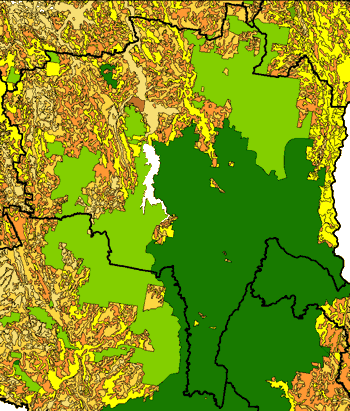
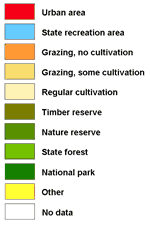
Source: NSW Department of Lands 2008
The majority of land in Tumut Shire is under landuse types compatible with the land capability class (Table 1). The Shire has approximately 20% of the Shire that has landuses not suited to land capabilities, therefore having the potential to cause erosion.
The Shire has 24% of land under grazing, 85% of this land is within its capability. The remainder of the grazing lands is in areas of high erosion risk if cleared; the Department of Lands recommends that these areas remain timbered.
Tumut Shire has 0.4% of land under horticulture, however approximately 56% of this land is not suitable for regular cultivation. Poor suitability for regular cultivation may be partially due to climatic variables as well as potential erosion. Another impact of this may include low crop yields.
Of the 2% of Tumut Shire classified as private timber plantations, approximately 10% of the land is classified under class VII. The area of land under land capability classes VII and VIII have a high erosion risk if cleared. Although much of the timber production forests within the state occur on these lands, they are not necessarily suited to forestry operations; the Department of Lands recommends that these areas remain timbered.
| Landuse | Land Capability Class | |||||||
|---|---|---|---|---|---|---|---|---|
| Lands suitable for regular cultivation | Lands suitable for grazing—occasional cultivation | Lands suitable for grazing—no cultivation | Other lands | |||||
| I | II | III | IV | V | VI | VII | VIII | |
| Estimated grazing | 10 | 9,604 | 6,404 | 31,558 | 12,374 | 32,908 | 14,719 | 13 |
| Horticulture | 283 | 473 | 05 | 57 | 87 | 9 | ||
| Other plantations | 12 | 23 | 2,589 | 30 | 4,039 | 773 | 6 | |
| Rural residential | 18 | 376 | 33 | 256 | 2 | |||
| Totals (hectares) | 10 | 9,917 | 6,900 | 35,328 | 12,494 | 37,291 | 15,504 | 20 |
Source: DLWC
Types of land degradation
Erosion
The data available on erosion extent in Tumut Shire is derived from surveys carried out between 1985 and 1992. These surveys indicated about 210 kilometres of gully erosion and about 190 kilometres of streambank erosion were present in the Shire at that time, as well as extensive areas of severe to minor sheet erosion.
Approximately half of the gully erosion measured in Tumut Shire are classed as severe to extreme, and most gullies were less than three metres deep (Table 2). Most erosion gullies in Australia would have formed soon after the native vegetation was removed, and although these gullies have since stabilised, they are continuing to contribute sediment loads to streams (Hughes and Prosser 2003). In New South Wales (NSW) overall, Edwards and Zierholz (2001) estimated that accelerated erosion rates were 10–50 times the natural rates.
Figure 2. Degree of erosion
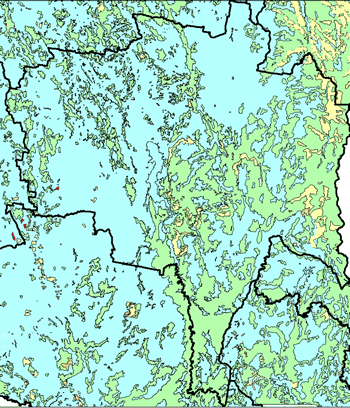
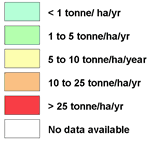
Source: NSW Department of Lands 2008
It is expected that some of the erosion may have occurred within Tumut Shire during the current reporting period due to the ongoing drought.
| Erosion type | Depth | Kilometres |
|---|---|---|
| Extreme gully erosion | 3 to 6m deep | 3 |
| 1.5 to 3m deep | 42 | |
| less than 1.5m deep | 22 | |
| Extreme gully erosion total | 67 | |
| Severe gully erosion | 1.5 to 3m deep | 14 |
| less than 1.5m deep | 21 | |
| Severe gully erosion total | 35 | |
| Moderate gully erosion | 1.5 to 3m deep | 16 |
| less than 1.5m deep | 32 | |
| Moderate gully erosion total | 48 | |
| Minor gully erosion | 3 to 6m deep | 0.3 |
| 1.5 to 3m deep | 13 | |
| less than 1.5m deep | 48 | |
| Minor gully erosion total | 61 | |
| Streambank erosion | greater than 6m deep | 6 |
| 3 to 6m deep | 9 | |
| 1.5 to 3m deep | 112 | |
| less than 1.5m deep | 59 | |
| Streambank erosion total | 186 |
Source: DIPNR data from 1985 to 1992
| Major erosion type | Degree / type | Hectares |
|---|---|---|
| Mass movement | rock debris avalanche | 211 |
| slide | 12 | |
| slump | 30 | |
| Rill erosion | extreme rill erosion | 35 |
| severe rill erosion | 119 | |
| moderate rill erosion | 375 | |
| minor rill erosion | 502 | |
| Sheet erosion | extreme sheet erosion | 58 |
| severe sheet erosion | 391 | |
| moderate sheet erosion | 16,019 | |
| minor sheet erosion | 158,844 |
Source: DIPNR data from 1985 to 1992
Salinity
Salinity is anticipated to become a growing problem in Tumut Shire . Existing salinity hazards only occur in one area, south of Tumut township. By 2050 the hazard is expected to increase with a salinity band extending up to the northern border of the Shire . Additional salinity hazards are expected to form in the towns of Adelong and Tumut. (Figures 3 and 4) (AWR 2005)
Figure 3. Extent of salinity (2000)
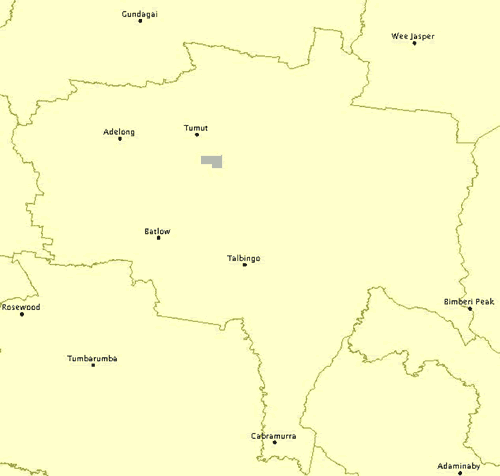
Source: Australin National Resource Atlas 2001
Figure 4. Estimated Extent of salinity (2050)
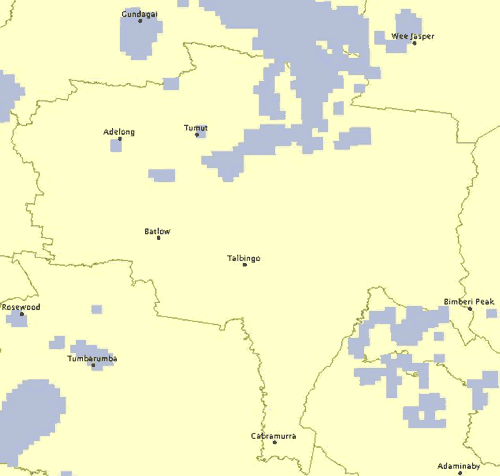
Source: Australin National Resource Atlas 2001
Acid soils
Approximately 19% of surface soils within Tumut Shire are classed as strongly acid (pH 3.5–5.5) in 2002 (DLWC, 2002b). These soils occur predominantly on agricultural land along Yaven Creek. Although many soils in high rainfall areas are naturally acid, the level of acidity in agricultural areas may be partially due to application of nitrogenous fertilizers, removal of produce, and build up of soil organic matter (Upjohn et al. 2005). Also approximately 26% of the Tumut Shire’s soils are classed as high to critical risk of soil acidification (DLWC, 2002a). This included most soils in agricultural areas across the Shire that were classed as slightly acid but had a high to critical risk of soil acidification.
Figure 5. Acidity of Soils in Tumut Shire
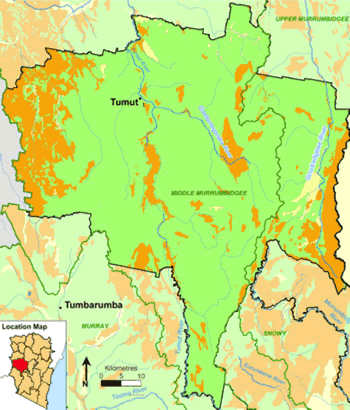

Source: Department of Primary Industries 2008
Impacts of soil acidity can include reduced crop yields, poor establishment of or failure of perennial pastures, permanent degradation of soil if acidity leaches to deeper soils, increase in soil erosion and siltation and recharge of aquifers leading to dryland salinity (Upjohn et al., 2005).
Causes of land degradation
Land degradation is generally directly or indirectly caused by human activities. Direct influences include land clearing, over use of fertiliser and altered water table. Indirect influences includes drought and flooding of overgrazed or over cultivated land with little ground cover to prevent erosion by wind and water. Drought breaking rain may also cause erosion and can make up about 90% of the total soil loss in an area in a 20–30 year cycle (DPI 2005).
Drought and vegetation condition
According to a recent study by the Bureau of Meteorology (BoM) and Commonwealth Scientific and Industrial Research Organisation (CSIRO) (BoM, CSIRO 2008) the frequency and extent of exceptionally hot years and exceptionally dry years in NSW are likely to increase in the future. The mean projections indicate that:
- by 2010-2040, exceptionally hot years are likely to affect about 60% of the region, and occur every 1.6 years on average;
- by 2010-2040, no change is likely in the frequency or areal extent of exceptionally low rainfall years; and
- by 2030, exceptionally low soil moisture years are likely to affect about 7% of the region and occur about once every 14 years on average.
As of September 2008 the Department of Primary Industry has classed 71.6% of NSW as ‘In drought’ including Tumut Shire.
Figure 6. Drought declared areas
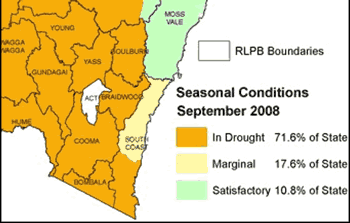
Source: NSW Department of Primary Indutries 2008
Over the reporting period the Gundagai Rural Land Protection Board, the authority covering the Tumut Shire , reported extended periods of drought (Table 4) (DPI 2008). This is further illustrated in Figure 7 where the continuing drought period resulted in a near 0% pasture growth for a 12 month period starting in September 2006 to September 2007 (NAMS 2008).
| Months | Seasonal Conditions |
|---|---|
| September 2004 | Drought |
| December 2004 | Satisfactory |
| March 2005 | Satisfactory |
| June 2005 | Drought |
| September 2005 | Marginal |
| December 2005 | Satisfactory |
| March 2006 | Satisfactory |
| June 2006 | Drought |
| September 2006 | Drought |
| December 2006 | Drought |
| March 2007 | Drought |
| June 2007 | Drought |
| September 2007 | Drought |
| December 2007 | Drought |
| March 2008 | Drought |
| June 2008 | Drought |
Figure 6. Pasture growth in the Tumut Shire for the period 2004 to 2008
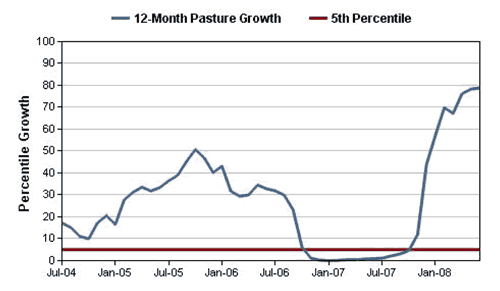
What is being done to improve land condition?
The Murrumbidgee Catchment Management Authority (CMA) in partnership with landholders revegetated a section of the Yaven Creek to enhance native vegetation and improve water quality. Funding was provided by the NSW State Government’s Section 10 Soil Conservation Program and the National Action Plan for Salinity and Water Quality, the project will stabilise the banks of Yaven Creek to allow for a healthier waterway.
In addition to this, Tumut Shire Council also supports a number of landcare groups to undertake on-ground works to help reduce many land issues such as erosion. Support is provided to these groups in conjunction with the Murrumbidgee CMA.
About the data
For the current reporting period there has been a lack of new soil data due to the relatively long intervals between soil studies. Given the relevancy of the information in the supplementary report, some sections have been retained for this report. Where material has been used from the supplementary report reference has been given to the report and original source.
References
Australian National Resource Atlas Mapmaker facility http://www.anra.gov.au/mapmaker/mapservlet?app=anra
Australian Water Resources (2000) National Land and Water Audit.www.nlwra.gov.au/
Australian Water Resources (2005) Land Salinity Maps.www.nlwra.gov.au/
AWR – see Australian Water Resources
BoM and CSIRO – see Commonwealth Scientific and Industrial Research Organisation
Bureau of Meteorology and Commonwealth Scientific and Industrial Research Organisation (2008) An Assessment of the Impact of Climate Change on the Nature and Frequency of Exceptional Climatic Event.
Commonwealth of Australia (2005) National Action Plan for Salinity and Water Quality and Natural Heritage Trust Regional Programs Report 2003–04, Departments of the Environment and Heritage and Agriculture, Fisheries and Forestry, viewed 18 April 2005, http://www.nrm.gov.au/publications/regional-report/03-04/.
CRCCH—see Cooperative Research Centre for Catchment Hydrology
Department of Infrastructure, Planning and Natural Resources, NSW (2004a) 2003/04 Combined NSW Catchment Management Authorities Annual Report, Volume 1: CMA Activities and Achievements, Department of Infrastructure, Planning and Natural Resources, Sydney.
Department of Infrastructure, Planning and Natural Resources, NSW (2005) Meeting the Challenge: NSW Salinity Strategy Premier's Annual Report 2003–04. NSW Department of Infrastructure, Planning and Natural Resources, viewed 12 May 2006, http://www.dlwc.nsw.gov.au/salinity/pdf/2003_2004_salinity_annual_report.pdf
Department of Land and Water Conservation (NSW) (1999) Groundwater Quality Protection Policy, Department of land and Water Conservation, Sydney, on line at http://www.dnr.nsw.gov.au/water/pdf/nsw_state_groundwater_quality_policy.pdf.
Department of Land and Water Conservation, NSW (2000) Taking on the Challenge: The NSW Salinity Strategy, Department of Infrastructure, Planning and Natural Resources, viewed 4 May 2006, http://www.dlwc.nsw.gov.au/salinity/government/govt-docs.htm.
Department of Land and Water Conservation, NSW (2002) Soil Acidification Hazard Mapping , produced for the 2003 NSW State of the Environment Report, Department of Land and Water Conservation, Parramatta.
Department of Primary Industries, NSW (2005) Soil Management Following Drought, Agnote DPI 355, Third Edition, Department of Primary Industries, viewed 18 April 2006, http://www.agric.nsw.gov.au/reader/pasture-crops-recovery/dpi355.htm.
Department of Primary Industries, NSW (2006) Drought maps—areas of NSW suffering drought conditions, Department of Primary Industries, viewed 8 May 2006, http://www.agric.nsw.gov.au/reader/drt-area?picQuant=100.
Department of Lands NSW (2008) Soil Landscape Mapping Program – Soil and Landscape Qualities and Limitations http://www.naturalresources.nsw.gov.au/care/soil/ssu/quals4.htm
DIPNR—see Department of Infrastructure, Planning and Natural Resources, NSW
DLWC—see Department of Land and Water Conservation, NSW
DPI—see Department of Primary Industries, NSW
Edwards, K and Zierholz, C (2001) Soil Formation and Erosion Rates, in PEV Charman and BW Murphy (eds) Soils: Their Properties and Management, 2nd Edition, pp 39–58, Oxford University Press, Oxford, cited in Lu, H, Prosser, IP, Monn, CJ, Gallant, JC, Priestley, G and Stevenson, JG (2003) Predicting sheetwash and rill erosion over the Australian continent, Australian Journal of Soil Research Vol. 41, 1037–1062, viewed 3 May 2006, http://palaeoworks.anu.edu.au/pubs/AustJSS03.pdf.
Hughes, AO and Prosser, IP (2003) Gully and Riverbank Erosion Mapping for the Murray-Darling Basin, Technical Report 3/03, March 2003, CSIRO Land and Water, Canberra, viewed 26 April 2006, http://www.clw.csiro.au/publications/technical2003/tr3-03.pdf.
National Agricultural Monitoring System (Namms) (2008), Simulated Pasture Growth for Tumut, http://www.nams.gov.au/
Upjohn, B., Fenton, G. and Conyers, M. (2005) Soil Acidity and Liming Agfact AC.19 3rd Edition. NSW Department of Primary Industries, viewed 17 July 2006, http://www.agric.nsw.gov.au/reader/soil-acid/2991-soil-acidity-and-liming-.pdf
